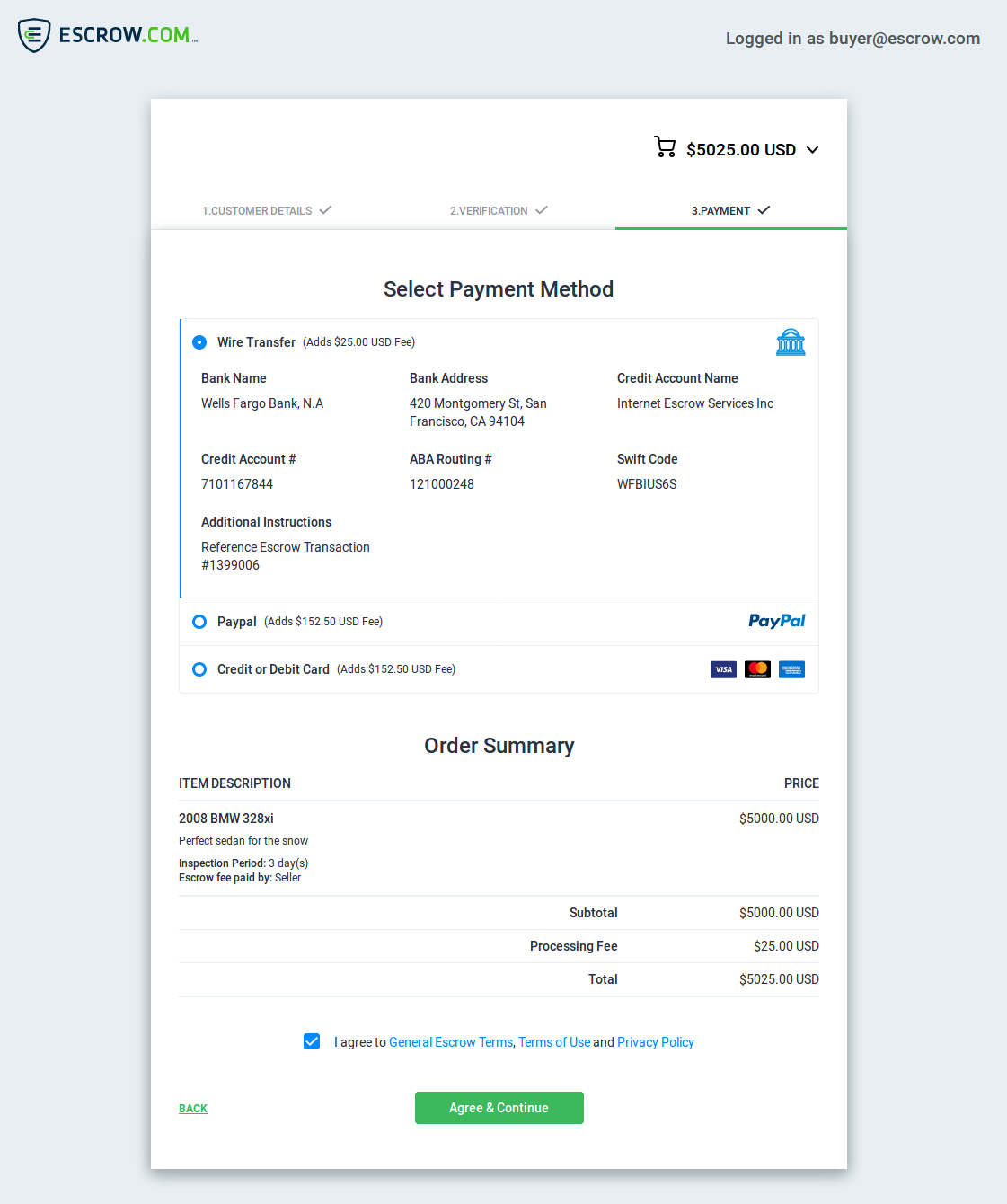Escrow Pay Documentation
What is Escrow Pay?
With no minimum fee and prices as low as 0.89%, Escrow Pay is the ideal solution for any website, mobile app, online store, classified site or marketplace that needs to take payments for any product or service of value. It allows buyers shopping online to make purchases safely and with confidence, whether they are spending $100 or $10,000,000 or more. Here is how it works:
- An online store or marketplace integrates the Escrow Pay API call on their listing or checkout pages. Since the store or marketplace only needs to implement a single API call, this can be done very easily.
- When the buyer checks out with Escrow Pay on the store or marketplace, a transaction is created on Escrow.com and the buyer is redirected to the Escrow Pay wizard on Escrow.com.
- The buyer secures their order by registering, verifying, and paying via the Escrow Pay wizard.
- All related actions and functionality for the transaction occur as usual.
Here is a screenshot of the Escrow Pay wizard that the buyer uses to make their payment:

Learn more about Escrow Pay and its benefits here.
Calling the Escrow Pay API
The call to the Escrow Pay API specifies how the transaction should be configured. This includes details about the item(s) being transacted, the buyer, the seller, the terms of the transaction, and optionally a broker for marketplace or commission scenarios.
Note
The Escrow Pay API supports all the transaction configurations that are available in the create transaction endpoint in the Escrow.com Platform API with the exception of Domain Name Holding transactions. However, there are two important changes: the customer object has been greatly expanded and the return_url attribute has been added. The customer object now allows the store or marketplace to pass relevant details such as the names, address, and date of birth of the buyer to Escrow.com in the Escrow Pay API request. When a return_url is specified in the request, the buyer will be redirected to that url when they have completed the Escrow Pay wizard.
- cURL
- Python
- Ruby
- PHP
- C#
1 2 3 4 5 6 7 8 9 10 11 12 13 14 15 16 17 18 19 20 21 22 23 24 25 26 27 28 29 30 31 32 33 34 35 36 37 38 39 40 41 42 43 44 45 46 47 48 49 50 51 52 53 54 55 56 57 58 59 60 61 62curl "https://api.escrow.com/integration/pay/2018-03-31" \ -X POST \ -u "email-address:your-api-key" \ -H "Content-Type: application/json" \ -d ' { "currency": "usd", "description": "Perfect sedan for the snow", "items": [ { "extra_attributes": { "make":"BMW", "model":"328xi", "year":2008 }, "fees": [ { "payer_customer": "me", "split": "1", "type": "escrow" } ], "inspection_period": 259200, "quantity": 1, "schedule": [ { "amount": 8000, "payer_customer": "[email protected]", "beneficiary_customer": "me" } ], "title": "BMW 328xi", "type": "motor_vehicle" } ], "parties": [ { "address": { "line1": "180 Montgomery St", "line2": "Suite 650", "city": "San Francisco", "state": "CA", "country": "US", "post_code": "94104" }, "agreed": true, "customer": "[email protected]", "date_of_birth": "1980-07-18", "first_name": "John", "initiator": false, "last_name": "Wick", "phone_number": "4155555555", "role": "buyer" }, { "agreed": true, "customer": "me", "initiator": true, "role": "seller" } ] }'
Example Response
1 2 3 4 5{ "landing_page": "https://www.escrow.com/pay?token=2d2afb9f-364f-4f9f-82a5-803344d60432", "token": "2d2afb9f-364f-4f9f-82a5-803344d60432", "transaction_id": 3300003 }
landing_page attribute
The landing_page attribute contains the link to which the buyer should be redirected.
token attribute
The token attribute contains the token which is used to identify the buyer's transaction on the the Escrow Pay wizard. While it is embedded in the landing_page, it is split out here for convenience.
transaction_id attribute
The transaction_id attribute contains the Escrow.com transaction identifier for the transaction that was created by the call to the Escrow Pay API. This is provided so that subsequent calls may be made to the standard Escrow.com API.
For help on making API calls and configuring transactions, please review the links below.
Retrieving a Pending Escrow Pay Transaction
A Pending Escrow Pay Transaction can be retrieved using the reference provided when creating the Escrow Pay transaction. This applies to all Escrow Pay Transactions that has a specific buyer.
- cURL
- Python
- Ruby
- PHP
- C#
1 2 3 4curl "https://api.escrow.com/integration/pay/2018-03-31?reference=test-transact" \ -X GET \ -u "email-address:your-api-key" \ -H "Content-Type: application/json" \
Example Response
1 2 3 4 5{ "landing_page": "https://www.escrow.com/pay?token=2d2afb9f-364f-4f9f-82a5-803344d60432", "token": "2d2afb9f-364f-4f9f-82a5-803344d60432", "transaction_id": 3300003 }
landing_page attribute
The landing_page attribute contains the link to which the buyer should be redirected.
token attribute
The token attribute contains the token which is used to identify the buyer's transaction on the the Escrow Pay wizard. While it is embedded in the landing_page, it is split out here for convenience.
transaction_id attribute
The transaction_id attribute contains the Escrow.com transaction identifier for the transaction that was created by the call to the Escrow Pay API. This is provided so that subsequent calls may be made to the standard Escrow.com API.